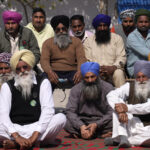
ATTARI, India — Charanjit Singh Channi, the chief minister of the Indian state of Punjab, has many of the elements to mount a successful election campaign in India’s politics.
He is from the state’s dominant party. He has doled out last-minute sweeteners, by waiving utility bills and reducing prices on necessities like fuel. And he has captured the imagination of India’s raucous television scene, offering viral moments that depict the 58-year-old chief minister, a former handball player, as a man of the people: breaking into bhangra dance routines at debate events; stopping his official convoy to help an injured biker; congratulating a newly married couple on the road.
Yet when this state of 30 million votes on Sunday to elect its new government, Mr. Channi is an underdog. Not only are the opposition parties trying to dislodge his Indian National Congress party from one of the last states where it remains in power, but his own ranks have also been unraveling amid messy infighting.
The vote in Punjab is shaping up as a broader test of whether Congress, which governed India for majority of its history since independence from British rule, can arrest its steep national decline in recent years following the rise of Prime Minister Narendra Modi. At the national level, Mr. Modi’s Bharatiya Janata Party has established itself as such an undisputed force in consecutive national elections that India’s democracy increasingly feels like a one-party rule, analysts and observers say.
Mr. Channi, in an interview between campaign rallies, acknowledged the pressures of his situation in a race with a significance to Congress beyond just Punjab, adding that he was focused only on what he could do. “I work hard, with dignity and effort, and the rest is up to the public.”
The Congress party, run by members of the Gandhi family at the top, is a shadow of its former self, with less than 10 percent of the seats in the Parliament and leading governments in just three of India’s 28 states. The party has won some victories in local elections, but not enough to fuel a national revival. Other regional parties that have been trying to form coalitions to challenge Mr. Modi have expressed frustration with what they see as Congress’s sense of historic entitlement, despite its shrinking numbers.
Several parties, including Mr. Modi’s B.J.P., are trying to gain seats when the votes for the Punjab assembly are tallied next month, along with the results of ongoing elections in some other states. In Punjab, an agrarian state struggling with rising farmer debt and unemployment, the main challenger is the Aam Admi Party, which is trying to expand nationally after sweeping to power in the capital region on an anti-corruption protest movement.
“There is a new game that has started among India’s opposition parties — to cannibalize on Congress,” said Rahul Verma, a political scientist at the Centre for Policy Research in New Delhi.
Mr. Verma said Congress’s woes were such that even a win in Punjab would not translate to broader momentum. If Congress loses, the damage could be more lethal — the party would struggle to justify clinging to the role of what he described as “the natural leader of the opposition.”
“If Channi succeeds to pull through, it is positive morale boosting,” Mr. Verma said, “but it doesn’t mean Congress can improve its situation drastically nationally.”
The Congress’s victory in Punjab in 2017 followed major defeats, including in the 2014 national elections when Mr. Modi first came to power. The party’s leaders wanted their victory in Punjab to be seen as the impetus for a national comeback.
“Congress will revive from here, get energy from Punjab, and spread,” Rahul Gandhi said after that 2017 victory. “Mark my words.”
That did not happen. The party endured another sweeping defeat at the hand of Mr. Modi in the 2019 general elections, its position so reduced in the national Parliament that it did not have enough seats to claim the title of the leader of opposition.
Its government in Punjab was marred by mismanagement, as discontent grew over pressures on farmers, rising prices, and worsening unemployment. Amrinder Singh, the chief minister, was seen as so disconnected that he started facing revolts from within his government.
Months before the assembly elections, the Congress leadership replaced Mr. Singh. But the shake-up, and the jockeying over his replacement, divided the party’s ranks. Amid the friction, Mr. Gandhi, who along with his mother and sister have been running the party in recent years, made what was lauded as an inspired choice. He selected Mr. Channi as the new chief minister, making him the first Dalit, from a community that occupies the bottom of India’s caste system, to hold the position in Punjab.
“I started crying,” said Mr. Channi, whose father ran a small shop renting out wedding tents, about receiving the call that declared him chief minister.
Mr. Channi, previously a cabinet minister under Mr. Singh, had about four months to correct some of the damage before Sunday’s elections. But other party leaders continued to see him as a stopgap solution who could be elbowed out.
Just two weeks before the vote, Mr. Gandhi reaffirmed that Congress would fight the Punjab election with Mr. Channi as their leader.
After his ouster as chief minister, Mr. Singh quickly formed his own party and teamed up with Mr. Modi’s B.J.P. to create a coalition. The Congress party has been trying to blunt some of the anti-incumbency sentiment in Punjab by blaming Mr. Singh. For his part, Mr. Singh has been criticizing Congress in terms that amount to attacks on his own record.
“Everyone in Punjab knows that the Congress has done nothing in the last five years but make money,” Mr. Singh said in a recent interview with Indian media.
The Aam Aadmi Party, or Common Man Party, founded by an anti-corruption crusader, has been trying to position itself as the answer to Punjab’s woes on health and education. Their members point to their record of improving government schooling in Delhi. In a “road show” on the final day of campaigning in Amristar, a convoy of hundreds of cars, trucks, and motorcycles wove through the streets urging voters to “give one chance” to the party.
At one of Mr. Channi’s rallies outside the city, thousands of people who had streamed in — on tractors, buses and motorcycles — waited for about four hours, entertained by a live band, before the chief minister arrived.
Jagroop Singh Sandhu, a 33-year-old farmer in the crowd, acknowledged the fatigue with Congress’s mismanagement and infighting. But Mr. Channi’s ability to connect with people, he said, was making the race about him rather than the party.
“There is a Channi wave,” Mr. Sandhu said. “It will be about what he has shown in his three months.”
Driving between rallies on Friday, Mr. Channi stopped his convoy when he saw a group of children playing soccer and ran to the field. The children swarmed around him excitedly. He took turns taking penalty shots at the goal, and then playing goalkeeper — the skill which had won him scholarships during his high school and university days when he played handball — as the children took shots.
His media team quickly posted a video on his Twitter account, edited in a way that showed Mr. Channi as both shooter and defender of the same shot — an apt metaphor for his party’s race.




